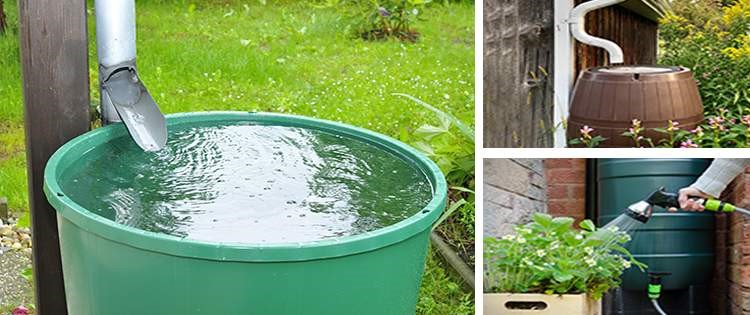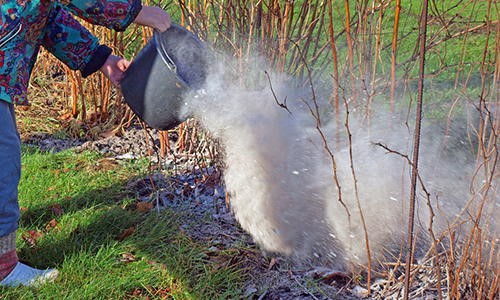Zucchini, often known as courgette, is a versatile and healthy vegetable that is a common ingredient in many cuisines throughout the world. It’s a common component in everything from salads and stir-fries to pasta and bread. But did you know you can grow your own zucchini in your own backyard or patio garden?
Growing zucchini is an excellent way to assure a steady supply of fresh, tasty veggies for your meals. It’s also an enjoyable and gratifying activity that both expert and novice gardeners may enjoy. With the right conditions and care, you may harvest an abundant harvest of zucchini all season long.
In this guide will walk you through the process of growing zucchini in your vegetable garden at home. From choosing the correct kind and preparing the soil to planting, caring for, and harvesting your zucchini, we’ll cover it all. We’ll also provide you with tips and tactics to assist you overcome frequent issues and ensure a great harvest.
A Brief History
Zucchini, or courgette, is a summer squash that originated in Central America and was domesticated by the Aztecs. It was brought to Europe by Spanish explorers in the 16th century, and has since become a popular vegetable in many countries worldwide.
Zucchini is easy to grow and can be harvested in as little as two months. It is a versatile vegetable that can be used in a variety of dishes, from salads to soups and sauces.
Zucchini has been grown for centuries for its nutritional benefits. It is rich in vitamins A, C and K, minerals such as potassium, magnesium, manganese and phosphorus, as well as dietary fiber. Zucchini is also low in calories and fat, making it an ideal choice for those looking to maintain a healthy weight.
Today, zucchini is grown in many parts of the world and is available year-round in most supermarkets. So why not try growing some at home? With the right preparation and care, you can enjoy delicious zucchini right from your own garden!
Nutritional Benefits
Zucchini is a nutritious vegetable that can easily be grown at home. It is an excellent source of vitamins, minerals and beneficial plant compounds, making it a great addition to any healthy diet.
Zucchini is a nutrient-dense vegetable that is high in key vitamins and minerals while being low in calories. It’s high in fibre, vitamin C, vitamin K, and potassium. It’s also high in antioxidants, which can help protect your cells from damage caused by dangerous chemicals known as free radicals.
A medium zucchini contains just 33 calories, making it an excellent complement to a low-calorie diet. It’s also low in carbohydrates and sugar, making it ideal for those on a low-carb or keto diet.
Zucchini’s high fibre content can aid digestion and relieve constipation. Zucchini contains vitamin C, which helps maintain a healthy immune system, and vitamin K, which is crucial for bone health and blood clotting. Zucchini contains potassium, which can help control blood pressure and promote heart health.
Zucchini includes trace levels of other vitamins and minerals, including vitamin B6, magnesium, and manganese, in addition to these. Therefore, incorporating zucchini into your diet may give a variety of nutritional advantages while also promoting general health and well-being.
Harvesting the zucchini at the right time will also allow them to reach their full nutritional potential before consumption. Knowing when and how to harvest properly will ensure that the zucchini are at their peak of flavor and nutrition.
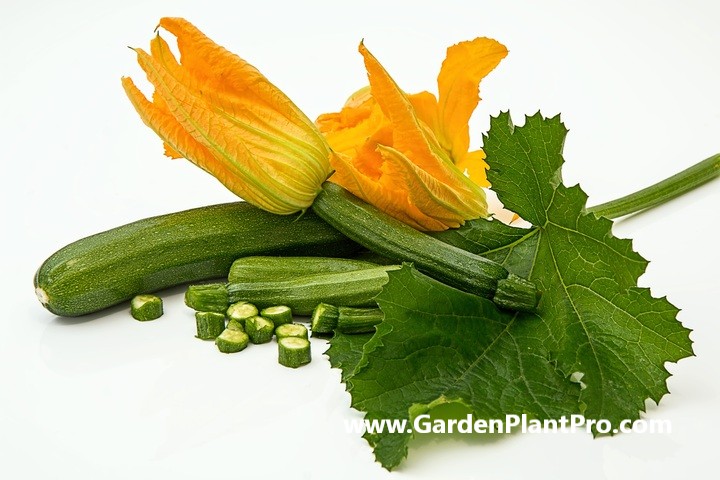
Common Varieties & Their Uses
When it comes to growing zucchini at home, it is important to understand the different varieties available and what they are used for. Zucchini plants come in a variety of shapes and sizes, each with their own unique characteristics. Here are some of the most popular varieties and how they can be used in the kitchen.
The classic green zucchini is the most common variety. It is a summer squash that is cylindrical in shape and can grow up to 12 inches long. The skin is thin and smooth and the flesh is juicy and sweet. This variety is excellent for slicing, cubing, roasting, sautéing, grilling, steaming, or stuffing with other ingredients.
Spaghetti squash is a unique variety of zucchini that has a mild flavor and stringy texture when cooked. When cooked, its flesh separates into spaghetti-like strands making it perfect for pasta dishes or as a substitution for noodles.
The golden zucchini has a slightly sweeter flavor than green varieties and can be eaten raw or cooked. It has a smooth yellow skin and mild flavor that makes it ideal for salads, grilled dishes, soups, stews, casseroles, stir-fries, and more!
Round zucchini are small and round with a bright green skin. They are usually harvested when they are about 2 to 3 inches in diameter. They have a crunchy texture and mild flavor that makes them perfect for dips, side dishes or salads.
Pattypan squash also known as scallopini or custard marrow is an heirloom variety that looks like a small scalloped-shaped disk. They have a mild flavor that pairs well with herbs or other vegetables making them ideal for soups and stews or as a side dish when roasted or grilled.
When To Sow
When it comes to sowing zucchini, timing is key.
DIY PROJECT: Collect rainwater no matter where you live...
This DIY project is the best way to legally collect rainwater NO MATTER where you live. Get chlorine-free water, cut down on your water bills, and have enough for an emergency situation or to water your garden. Read More Here...
Planting too early in the season can lead to poor germination, while planting too late can result in a shorter harvest season. The best time to sow zucchini seeds or seedlings is when the soil temperature is at least 16°C (60°F). This is usually about two weeks after the last spring frost for your area.
It’s also important to consider the type of zucchini you are planting. If you’re working with a bush variety, you can plant it directly into your garden bed. For vining varieties, however, you may want to start the seeds indoors about 2-4 weeks before your last spring frost date and then transfer them outside when they are large enough.
Choosing A Suitable Location In The Garden
Choosing a suitable location to plant zucchini is an important step in ensuring a successful crop. Zucchini prefer a sheltered position in full sun, with a fertile soil that holds plenty of moisture. They are reasonably large plants, so need plenty of space to spread out. Being subtropical, zucchini are best planted in a sunny position with warm temperatures and lots of direct sun.
When looking for a spot to plant zucchini, make sure it is warm and sheltered from strong winds. The soil should be fertile, well-drained and rich in organic matter. Zucchini can do well in pots or troughs but they will require at least 400mm width. If planting several zucchinis together, they should be planted in hills to ensure increased pollination.
It’s also important to consider the companion plants you’ll have alongside your zucchini when planting. Some plants like beans, tomatoes, basil and oregano are all good choices as they help to deter pests and improve the quality of the soil around the zucchini patch.
Preparing The Soil
One of the most important steps to successfully growing zucchini is to prepare the soil.
It is important to use nutrient-rich soil for zucchini plants and hilling is a great way to do this. Hilling is a process that involves creating mounds of soil around the base of each plant. This helps promote drainage and gives the plants an extra boost of nutrients.
To prepare the soil, start by removing any weeds, rocks, or other debris. Then, loosen the soil with a tiller or shovel and add in organic matter such as compost or leaf mulch to improve drainage and increase fertility. Mix this material into the top 8-10 inches of soil. Zucchini needs plenty of nitrogen-rich fertilizer, so adding a fertilizer specifically designed for vegetables can also help ensure your plants are getting all the nutrients they need.
Once the soil is ready, it’s time to plant your zucchini seeds or seedlings. Make sure to space them appropriately according to the variety you’re planting and water them thoroughly. Cover the plants with mulch if desired to help conserve moisture and control weeds. Finally, keep an eye on your plants for signs of disease or pests and take appropriate action if necessary. With proper preparation, care, and maintenance you can be sure that your zucchini plants will thrive!
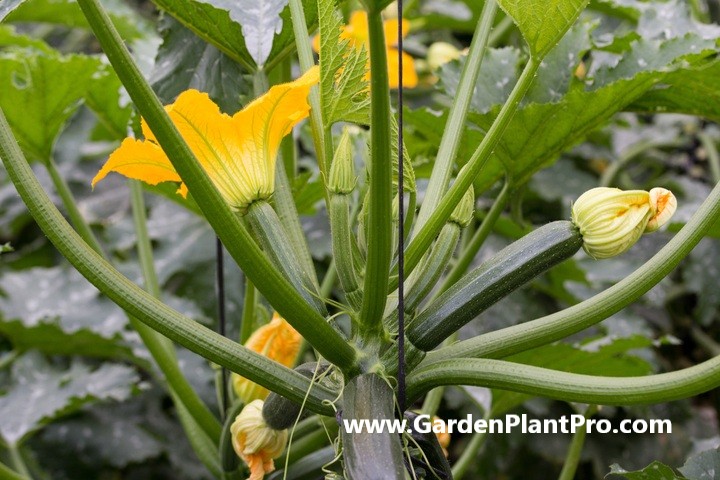
Planting The Seeds Or Seedlings
When it comes to planting the seeds or seedlings of zucchini, there are a few things to consider.
Firstly, you should decide whether you want to sow the seeds directly into the soil or purchase and transplant seedlings. If you opt to sow the seeds, they should be planted after the last frost has passed and in an area that receives full sun.
Create a mound of soil about 6 to 12 inches high and 12 to 24 inches wide. On the top of the hill, plant four or five zucchini seeds. Water the area well and keep moist until germination occurs.
If you choose to transplant seedlings, select those with healthy foliage and no signs of disease. Space them 36 inches (92 cm) apart and make sure that they are planted at the same depth as they were in their previous pot or tray. Water them in well and keep soil moist until they’ve established themselves in the garden.
No matter which method you choose, thin out seedlings when they reach 6 to 8 inches (15-20 cm) tall, leaving only two of the strongest plants per hill. Once established, regular watering and fertilizing will help promote healthy growth and abundant yields.
Caring For The Seedlings
Once zucchini seedlings have been planted, it is important to ensure they are given the right care in order to ensure optimal growth and yield. For best results, zucchini plants should be kept well-watered and mulched regularly to help lock in soil moisture. Regular fertilizing will also help the plants thrive, as will thinning out the seedlings to leave only the two strongest. Additionally, keeping an eye out for any common diseases or pests should be undertaken in order to prevent any damage.
When it comes to watering, be sure to keep the soil consistently moist – but not soggy – throughout the growing season. Water deeply at least once a week and always water in the morning so that any excess moisture can evaporate during the day. It is also recommended that you top up mulches occasionally in order to help lock in soil moisture and regulate temperature fluctuations.
Fertilizing your zucchini plants is also key for healthy growth, as it will supply additional nutrients that may be lacking in your garden’s soil. Using a balanced fertilizer with equal parts nitrogen, phosphorus, and potassium is typically recommended for best results.
Do you have some charcoal in your house right now? We call charcoal a “miracle leftover” for anyone who wants to be a little more self-sufficient and cut costs. That’s because it can help you with so many different things around the house and garden. You can even use it to make an energy-free fridge. Read More Here...
Finally, thin out your seedlings when they reach about 4 inches high or have four true leaves each. Snip off all but the two strongest seedlings at ground level with sharp scissors or shears. This will ensure that your plants are not overcrowded and have enough room to grow to their full potential.
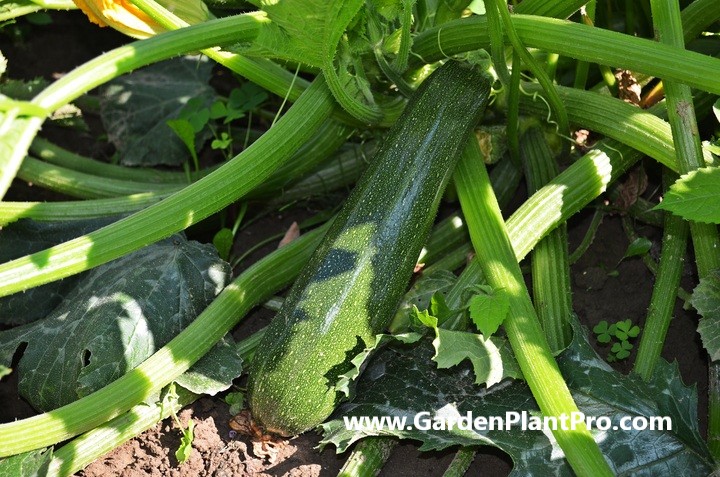
When & How To Harvest
Once the zucchinis have reached maturity, it’s time to harvest.
Generally, zucchini are ready for harvesting after 60 days from planting. However, smaller varieties may be ready sooner, within a week of flowering. To harvest the zucchini, use pruning shears to cut them from the vine. Make sure to leave at least one inch of stem attached to each zucchini.
It is important to check the zucchinis regularly for signs of ripeness and pick them when they are still small and tender. If allowed to over-ripen, they can become tough and fibrous.
When checking for ripeness, look for a glossy skin with no blemishes or discoloration and a firm texture. The size of the zucchinis will depend on their variety; some can be as small as four inches while others can grow up to three feet.
Once harvested, store your zucchinis in a cool and dry place. They can also be frozen or canned for later use. If you plan on freezing them, blanch them first in hot water or steam before putting them in the freezer to help preserve their texture and flavor.
Harvesting your zucchinis is an exciting time! With proper preparation and care, you will be able to enjoy your home-grown produce for months to come.
Storing & Preserving
When it comes to storing and preserving the zucchini you have grown in your garden, there are several options available. The most important factor to consider when storing zucchini is the humidity and temperature of the environment. Zucchini should preferably be stored at 80% to 85% humidity, at a temperature of no more than 41°F.
If you are looking for a longer-term storage solution, then drying is a great option. To dry zucchini, simply slice it into thin pieces and place them on a baking tray. Place the tray in an oven preheated to 125°F and bake until the pieces are brittle. Dried zucchini should be stored in a moisture-proof container in a dark, dry place. It will keep for up to one year.
Alternatively, you can freeze your zucchini for up to 8 months. To do this, first chop or slice the zucchini before placing it into boiling water for 30 seconds. Remove it from the boiling water and plunge it into icy cold water. Once cool, drain off any excess water before packing the pieces into airtight containers or freezer bags. This will help to keep your zucchini fresh and tasty for longer periods of time.
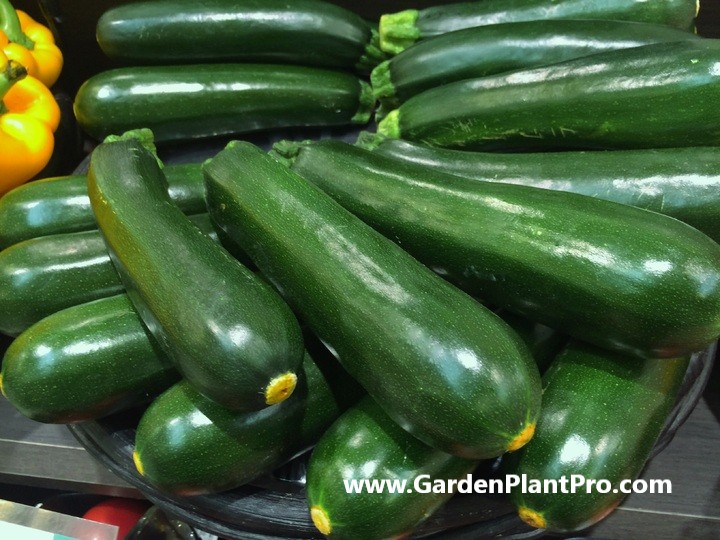
Common Diseases & How To Control Them
Zucchinis, like any other vegetable, can fall victim to a variety of diseases.
These can range from mildew and blossom end rot to cucumber mosaic virus, powdery mildew and bacterial wilt. To keep your zucchinis healthy, it’s important to be aware of the different signs of disease and take appropriate steps to prevent or control them.
When it comes to preventing disease, crop rotation is key. Be sure to rotate your crops at least every two years and buy certified disease-free seed. Additionally, be sure to keep weeds away from your zucchinis as they can spread disease.
If your plants are infected, pull them and don’t compost these as some fungal diseases can survive in the compost heap. You may also want to apply a fungicide spray such as neem oil or sulfur to help prevent further spread.
Powdery mildew is a common fungal disease easily identified by its white powdery coating on the leaves. To control this disease remove any infected leaves and apply a fungicide spray such as neem oil or sulfur.
Blight is another fungal disease that causes leaves to turn yellow or brown before dying off completely. To control this disease make sure you water your plants at their base rather than on the leaves and avoid over-fertilizing them with nitrogen-rich fertilizers.
Cucumber mosaic virus is a viral infection that causes yellow mottling on the leaves and curling of the stems and fruit. To control this virus use resistant varieties or plant in an area where no wild cucurbits have grown.
CASE STUDY: We've been living off the grid for the last 40 years...
In all that time an electric wire has never been connected to our house. We haven’t gotten or paid an electricity bill in over 40 years, but we have all the electricity we want. We grow everything we need, here, in our small backyard. We also have a small medicinal garden for tough times. Read More Here...
Common Pests & How To Control Them
Common garden pests can be a nuisance when growing zucchini at home, so it’s important to know how to control them. The most common pest problems include squash vine borers, cucumber beetles, cutworms and other insects.
Squash bugs: These bugs are a common pest for zucchini and can cause significant damage to the leaves and fruit of the plant. They can be controlled by handpicking or using insecticidal soap.
Cucumber beetles: These pests can transmit bacterial wilt disease to zucchini plants, causing the leaves to wilt and turn yellow. They can be controlled by handpicking or using insecticidal soap.
Aphids: These small insects can cluster on the leaves and stems of zucchini plants, sucking the sap from the plant and causing it to wilt. They can be controlled by spraying the plant with a strong stream of water or using insecticidal soap.
Spider mites: These tiny pests can infest the undersides of zucchini leaves, causing them to turn yellow and dry out. They can be controlled by spraying the plant with a strong stream of water or using insecticidal soap.
To prevent pests from infesting your zucchini plants, it’s important to keep the area around your plants clean and free of debris. Removing dead leaves and plant debris can help reduce the likelihood of pests and diseases.
You can also use natural pest control methods, such as companion planting. Planting herbs like basil, dill, and marigolds alongside your zucchini can help repel pests and attract beneficial insects like ladybugs and lacewings.
Finally, if you do use insecticides, be sure to read and follow the label instructions carefully, as some insecticides can be harmful to beneficial insects and can also leave residues on the zucchini fruit.
Beneficial Companion Plants
Growing zucchini is an enjoyable and rewarding experience. To ensure a healthy harvest, it’s important to choose companion plants that will benefit the zucchini.
A classic combination is beans and corn; these two plants help each other to grow and thrive, while also providing shelter for the zucchini from pests.
Aromatic herbs such as oregano, marjoram, sage, and rosemary are also great companion plants for zucchini. These herbs will not compete for water or nutrients with the zucchini, and they can help to repel certain pests.
Nasturtiums are another great addition to your zucchini patch. Plant them around the circumference of your garden bed to provide natural pest control. Their bright colors can also make your garden a more attractive space.
Marigolds are a perfect choice for companion planting with zucchini. Marigolds exude an aroma that repels many pests, while also adding color and beauty to your garden bed.
By selecting the right companion plants for your zucchini patch, you will be able to enjoy a healthy and bountiful harvest of this versatile vegetable.
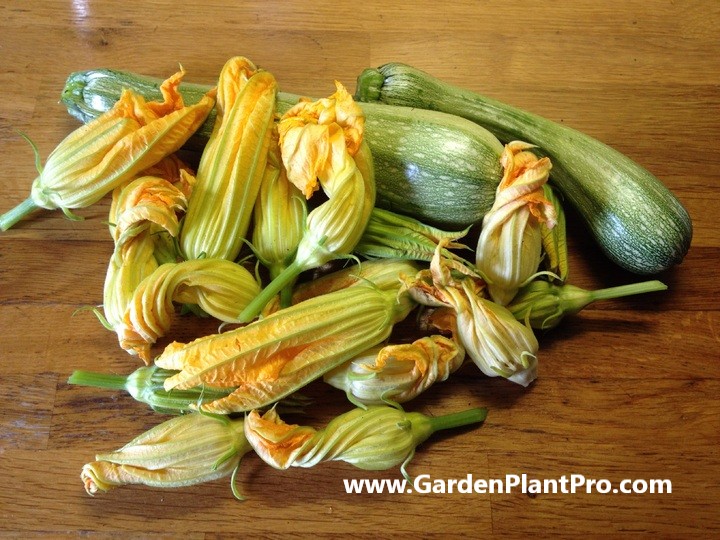
Using Your Home Grown Zucchini
Using your home grown zucchini is a great way to enjoy the fresh, delicious taste of this versatile summer squash. With a few simple steps and a little care, you can have zucchini ready to harvest in no time.
When harvesting zucchini, it’s best to pick them when they are small and tender. Larger zucchinis can become tough and fibrous, so it’s best to pick them early. Look for zucchinis that are dark green in color and have a glossy sheen. The skin should be slightly firm to the touch with no soft spots or bruises. You can also tell if a zucchini is ready to harvest by its size – most varieties will be ready when they reach 8-10 inches in length.
Once harvested, you can store your zucchinis in the refrigerator for up to 5 days in an airtight container. If you need to store them for longer, you can freeze them by blanching the cut pieces first before freezing them in sealed containers or bags.
When it comes to cooking your home grown zucchinis there are countless recipes available online or in cookbooks that make use of this delicious summer squash. It’s particularly delicious as part of stir-fries, grilled dishes, soups and salads.
You can also bake it into breads and muffins, stuff it with other vegetables or proteins like meat or tofu, add it to quiches and frittatas, or simply sauté it with some herbs and spices for a quick side dish. Zucchini is also a great way to add extra moisture and flavor to burgers and meatloaf without adding too many calories.
Experiment with different recipes and ingredients until you find the one that works best for you!


